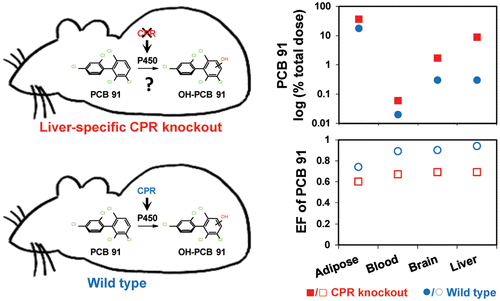当前位置:
X-MOL 学术
›
Chem. Res. Toxicol.
›
论文详情
Our official English website, www.x-mol.net, welcomes your
feedback! (Note: you will need to create a separate account there.)
Atropselective Disposition of 2,2',3,4',6-Pentachlorobiphenyl (PCB 91) and Identification of Its Metabolites in Mice with Liver-Specific Deletion of Cytochrome P450 Reductase.
Chemical Research in Toxicology ( IF 3.7 ) Pub Date : 2019-08-12 , DOI: 10.1021/acs.chemrestox.9b00255 Xianai Wu , Guangshu Zhai , Jerald L. Schnoor , Hans-Joachim Lehmler
Chemical Research in Toxicology ( IF 3.7 ) Pub Date : 2019-08-12 , DOI: 10.1021/acs.chemrestox.9b00255 Xianai Wu , Guangshu Zhai , Jerald L. Schnoor , Hans-Joachim Lehmler

|
Hepatic cytochrome P450 enzymes metabolize chiral polychlorinated biphenyls (PCBs) to hydroxylated metabolites (OH-PCBs). Animal models with impaired metabolism of PCBs are one approach to study how the atropselective oxidation of PCBs to OH-PCBs contributes to toxic outcomes, such as neurodevelopmental disorders, following PCB exposure. We investigated the disposition of PCB 91, a para-substituted PCB congener, in mice with a liver-specific deletion of the cytochrome P450 reductase (cpr) gene (KO mice). KO mice and wild-type (WT) mice were exposed orally to racemic PCB 91 (30 mg/kg b.w.). Levels and enantiomeric fractions of PCB 91 and its hydroxylated metabolites were determined in tissues 3 days after PCB exposure and in excreta on days 1–3 after PCB exposure. PCB 91, but not OH-PCB levels were higher in KO compared to WT mice. The elevated fat and protein content in the liver of KO mice resulted in the hepatic accumulation of PCB 91. OH-PCBs were detected in blood, liver, and excreta samples of KO and WT mice. 2,2′,3,4′,6-Pentachlorobiphenyl-5-ol (5-91) was the major metabolite. A considerable percent of the total PCB 91 dose (%TD) was excreted with the feces as 5-91 (23%TD and 31%TD in KO and WT mice, respectively). We tentatively identified glucuronide and sulfate metabolites present in urine samples. The PCB 91 atropisomer eluting first on the chiral column (E1-PCB 91) displayed genotype-dependent atropisomeric enrichment, with a more pronounced atropisomeric enrichment observed in WT compared to KO mice. E1-atropisomers of 5-91 and 2,2′,3,4′,6-pentachlorobiphenyl-4-ol (4-91) were enriched in blood and liver, irrespective of the genotype; however, the extent of the enrichment of E1-5-91 was genotype dependent. These differences in atropselective disposition are consistent with slower metabolism of PCB 91 in KO compared to WT mice and the accumulation of the parent PCB in the fatty liver of KO mice.
中文翻译:

2,2',3,4',6-五氯联苯(PCB 91)的Atroselective处理和小鼠肝脏特异性删除细胞色素P450还原酶的代谢产物的鉴定。
肝细胞色素P450酶将手性多氯联苯(PCB)代谢为羟基化代谢物(OH-PCBs)。PCB代谢受损的动物模型是研究PCB暴露于OH-PCB的Atropselective氧化如何导致毒性结果(如PCB暴露后的神经发育障碍)的一种方法。我们调查了具有肝特异性细胞色素P450还原酶(cpr)的小鼠对PCB 91(一种对位取代的PCB同系物)的处置)基因(KO小鼠)。KO小鼠和野生型(WT)小鼠经口服外消旋PCB 91(30 mg / kg bw)暴露。在PCB暴露3天后的组织中以及在PCB暴露后1-3天的粪便中测定PCB 91及其羟基化代谢物的水平和对映体分数。与野生型小鼠相比,KO中的PCB 91含量较高,但OH-PCB含量却没有较高。KO小鼠肝脏中脂肪和蛋白质含量的升高导致肝中PCB 91的积累。在KO和WT小鼠的血液,肝脏和排泄物中检测到OH-PCBs。2,2',3,4',6-五氯联苯-5-醇(5-91)是主要的代谢产物。粪便中的总PCB 91剂量(%TD)中有相当大的百分比以5-91排泄(KO和WT小鼠中分别为23%TD和31%TD)。我们初步确定了尿液样品中存在的葡萄糖醛酸和硫酸盐代谢产物。1- PCB 91)显示出基因型依赖性的阻转异构体富集,与KO小鼠相比,在WT中观察到更明显的阻转异构体富集。不论基因型如何,5-91和2,2',3,4',6-五氯联苯-4-醇(4-91)的E 1-异构体富含血液和肝脏。然而,E 1 -5-91的富集程度是基因型依赖性的。与WT小鼠相比,这些非选择性选择性差异与KO中PCB 91的新陈代谢较慢以及KO小鼠脂肪肝中母体PCB的积累相一致。
更新日期:2019-08-12
中文翻译:

2,2',3,4',6-五氯联苯(PCB 91)的Atroselective处理和小鼠肝脏特异性删除细胞色素P450还原酶的代谢产物的鉴定。
肝细胞色素P450酶将手性多氯联苯(PCB)代谢为羟基化代谢物(OH-PCBs)。PCB代谢受损的动物模型是研究PCB暴露于OH-PCB的Atropselective氧化如何导致毒性结果(如PCB暴露后的神经发育障碍)的一种方法。我们调查了具有肝特异性细胞色素P450还原酶(cpr)的小鼠对PCB 91(一种对位取代的PCB同系物)的处置)基因(KO小鼠)。KO小鼠和野生型(WT)小鼠经口服外消旋PCB 91(30 mg / kg bw)暴露。在PCB暴露3天后的组织中以及在PCB暴露后1-3天的粪便中测定PCB 91及其羟基化代谢物的水平和对映体分数。与野生型小鼠相比,KO中的PCB 91含量较高,但OH-PCB含量却没有较高。KO小鼠肝脏中脂肪和蛋白质含量的升高导致肝中PCB 91的积累。在KO和WT小鼠的血液,肝脏和排泄物中检测到OH-PCBs。2,2',3,4',6-五氯联苯-5-醇(5-91)是主要的代谢产物。粪便中的总PCB 91剂量(%TD)中有相当大的百分比以5-91排泄(KO和WT小鼠中分别为23%TD和31%TD)。我们初步确定了尿液样品中存在的葡萄糖醛酸和硫酸盐代谢产物。1- PCB 91)显示出基因型依赖性的阻转异构体富集,与KO小鼠相比,在WT中观察到更明显的阻转异构体富集。不论基因型如何,5-91和2,2',3,4',6-五氯联苯-4-醇(4-91)的E 1-异构体富含血液和肝脏。然而,E 1 -5-91的富集程度是基因型依赖性的。与WT小鼠相比,这些非选择性选择性差异与KO中PCB 91的新陈代谢较慢以及KO小鼠脂肪肝中母体PCB的积累相一致。






























 京公网安备 11010802027423号
京公网安备 11010802027423号